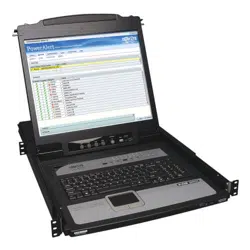Loading ...
Loading ...
Loading ...

35
7. Administration
(
continued
)
Port Configuration
When accessing the KVM via AP Windows or Java Client, right-click
on any port in the Sidebar to configure a connected computer or
switch. (This feature is not available when accessing the OSD via
web browser.) A list with options pops up. Listed items vary
depending on user type. Available configuration items are:
Item Access Type Description
Expand/ Collapse Super Administrators, Administrators and
Users
• If the device’s ports are not displayed, the dialog box entry is Expand.
Click Expand to open the tree and display the ports.
• If the device’s ports are displayed, the dialog box entry is Collapse. Click
Collapse to close the tree view.
Note: This item is only active for KVM switches that have child devices connected to
them. This has the same effect as clicking the Plus (+) or Minus (-) in the tree view.
Copy Super Administrators, Administrators
and Users
This item is only available for ports with computers/servers connected to them. It is
used when creating a Favorites bookmark. (See Adding a Favorite section under
Favorites in OSD Operation for details.)
Port Naming
To assign, modify or delete a port name, follow the instructions below.
Note: Administrators and Users must be given configuration access to a KVM or computer port to be able to edit the port name. (See Device
Assignment section under User Management in OSD Operation for details.)
1. Click once on the port you want to edit to highlight it, wait one second and click on it again.
Note: This is not a double-click; it involves two separate clicks. Double-clicking will switch you to the device attached to the port.
After a second or two, the display changes to provide a text input box.
2. Key in a name for the port (or change/delete a previous one). The maximum number of characters allowed for a port name is 20. You can
use any combination of letters, numbers, and symbols on the typewriter keys of keyboards with PC US English layout.
3. When you have finished editing the port name, press [Enter] or click anywhere outside of the input box to complete the operation.
Scan
The Scan function automatically switches among all the ports accessible to the logged-on user at regular intervals, allowing their activity to be
monitored automatically. (See Auto Scanning section under Remote Session Operation for details.)
Note: The Scan icon will not appear when accessing the KVM switch via web browser.
Panel Array Mode
Panel Array Mode also permits port activity to be monitored automatically. The screen displays a grid of panels, each representing a port on
the installation. Only ports that are online and user accessible are displayed. Offline or non-accessible ports are left blank. (See Panel Array
Mode section under The OSD Toolbar in Remote Session Operation for details.)
The Port Selection List
• Users only see the switches and ports they have been given access
to.
• Ports are located under their parent switches. Click the Plus (+) in
front of a switch to expand the tree and see the ports underneath
it.
•
When expanded, there is a Minus (-) before the KVM’s device
name. Click the Minus (-) to collapse the tree and hide the ports.
• A port’s ID number is displayed in brackets next to the port icon.
For convenience, you can give each port a unique name in
addition to this ID.
• KVM switches and ports that are on line have their monitor screen
icons lit green. The monitor screens are gray for devices and ports
that are offline.
Loading ...
Loading ...
Loading ...
